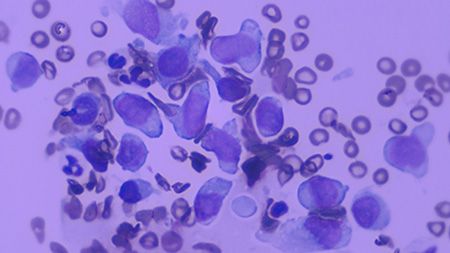Image Quiz: What do you see in this cytology slide?
Sample was taken from the dorsal trunk of an 8-year-old male golden retriever.

Image courtesy of Dr. Chris Reeder.This image shows the skin cytology of a sample from the dorsal trunk of an 8-year-old male neutered golden retriever. What's your diagnosis?
A. Acantholytic cells
B. Agranular mast cells
C. Atypical lymphocytes
D. Fibroblasts
Correct answer: C. Atypical lymphocytes.
This dog was diagnosed with cutaneous lymphoma. These atypical lymphocytes are characterized by large round cells that have minimal cytoplasm and large deeply basophilic nuclei with finely stippled chromatin. Often the nuclei are more centrally placed compared with macrophages and will not have an activated "foamy" appearance. They are mostly seen in large clusters and not individually. Occasionally many neutrophils will be present around them as well. They are an indication to biopsy the skin to further confirm lymphoma.

Cutaneous lymphoma carries an overall poor prognosis; however, several treatment options are available. Clinically, these patients are typically older with excess scaling, erythema and possible plaques on the dorsal trunk, though any area of the skin including the nose and paw pads can be affected. Cutaneous lymphoma presents in different phases-patch, plaque and nodular-as it progresses.
Dr. Chris Reeder practices at BluePearl Veterinary Partners in Franklin, Tennessee, with a special interest in ear disease and immune-mediated skin diseases. He is an avid hobby farmer raising a large number of critters.